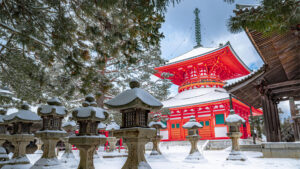Japanese literature has cultivated a unique world that embraces intense emotions and deep philosophy within quiet and delicate expression.
From the modern era to the present day, many writers have woven the inner struggles of the human heart, social changes, and uniquely Japanese cultural values into their works, producing numerous literary masterpieces.
In this article, we introduce 15 carefully selected works that we highly recommend to international readers.
Through unforgettable stories, beautiful prose, and timeless themes, you’ll discover the richness and diversity of Japanese literature.
Contents
- 1 Kokoro (Natsume Sōseki)
- 2 No Longer Human (Osamu Dazai)
- 3 Rashōmon (Ryūnosuke Akutagawa)
- 4 The Spider’s Thread (Ryūnosuke Akutagawa)
- 5 The Temple of the Golden Pavilion (Yukio Mishima)
- 6 Lemon (Kaji Motojirō)
- 7 The Moon over the Mountain (Atsushi Nakajima)
- 8 The Woman in the Dunes (Kobo Abe)
- 9 Night on the Galactic Railroad (Kenji Miyazawa)
- 10 Black Rain (Masuji Ibuse)
- 11 Edogawa Rampo Masterpieces (Rampo Edogawa)
- 12 The Restaurant of Many Orders (Kenji Miyazawa)
- 13 Fires on the Plain (Shohei Ooka)
- 14 Norwegian Wood (Haruki Murakami)
- 15 The Setting Sun (by Osamu Dazai)
- 16 Timeless Japanese Literary Masterpieces That Transcend Eras and Borders
Kokoro (Natsume Sōseki)
— A Masterpiece Depicting Friendship, Betrayal, and the Spiritual Struggles of the Meiji Era
Kokoro is a representative work by Natsume Sōseki, one of the greatest figures in modern Japanese literature. Through the relationship between the mysterious “Sensei” and the young narrator “I,” the novel deeply explores themes of loneliness, guilt, and the inner turmoil of individuals caught in the wave of modernization during the Meiji period.
The story unfolds around the narrator’s growing friendship with Sensei, a man who seems to carry a shadow of the past and keeps others at a distance. Behind this behavior lies a past betrayal and the overwhelming guilt that continues to haunt him.
Structured in three parts, the novel builds toward a powerful conclusion in which Sensei’s will reveals the secrets of his past. Themes of friendship, love, death, and personal responsibility are interwoven with the psychological backdrop of Meiji-era Japan, offering a subtle yet profound reading experience.
Sōseki’s quiet and beautiful prose conveys deep emotional conflict, making this a perfect introduction for readers new to Japanese literature.

Kokoro
by Natsume Soseki and Edwin McClellan

Kokoro (Mint Editions)
by Natsume Sōseki and Mint Editions

Kokoro
by Natsume Sōseki
No Longer Human (Osamu Dazai)
— A Semi-Autobiographical Masterpiece of Self-Loss and Isolation
No Longer Human is one of the final and most iconic works by Osamu Dazai, a prominent figure in postwar Japanese literature. Written in the form of a personal record, the story follows a man named Ōba Yōzō as he struggles with overwhelming feelings of self-denial, alienation, and emotional despair.
In public, Yōzō wears a mask of humor and lightheartedness to hide his true self, but privately he is tormented by anxiety and self-loathing. Unable to find meaning in life, he gradually spirals into a world of alcohol, women, and drugs, losing all connection to society. His descent is portrayed with raw honesty and psychological depth.
Yōzō’s story is not unique—it resonates with anyone who has ever feared being truly seen or felt lost within the expectations of society. Deeply autobiographical, the novel reflects Dazai’s own inner turmoil and emotional struggles.
Despite its themes of despair, the prose is hauntingly beautiful and lyrical, leaving a lasting impression on readers.
Even today, No Longer Human continues to captivate a wide audience, especially among younger generations, as one of the most enduring masterpieces of modern Japanese literature.

No Longer Human
by Osamu Dazai and Donald Keene

No Longer Human: A New Translation
by Osamu Dazai and Juliet Winters Carpenter

No Longer Human
by Osamu Dazai and Seren Aeon
Rashōmon (Ryūnosuke Akutagawa)
— A Landmark Short Story That Questions the Boundary Between Good and Evil
In the upper floor of the Rashōmon gate, the man encounters an old woman pulling hair from corpses to make wigs. Though shocked at first, he listens as she justifies her actions by claiming it is necessary to live. This moment triggers a shift in his moral compass, leading him to decide that he, too, will steal in order to survive.
This pivotal decision captures the collapse of conventional morality under extreme conditions. With concise, suspenseful prose, Akutagawa crafts a story that leaves a lasting impact despite its brevity. Rashōmon remains one of the defining works of Japanese literature, offering a philosophical tale that still resonates in modern times. Its exploration of ethics, desperation, and the fragility of human judgment makes it essential reading for those interested in the complexities of moral choice.

Rashomon and Seventeen Other Stories
by Ryunosuke Akutagawa, Jay Rubin, et al.
Penguin Classics Deluxe Edition

Rashomon and Other Stories
by Ryunosuke Akutagawa

Ryunosuke Akutagawa Collection
by Ryunosuke Akutagawa and Robert Jordan G
Includes: Kappa, Rashomon, In a Grove, The Spider’s Thread, Hell Screen, and The Nose
The Spider’s Thread (Ryūnosuke Akutagawa)
— A Buddhist Allegory of Salvation and Selfishness
The Spider’s Thread is a short story written by Ryūnosuke Akutagawa originally for children, yet it delivers a profound moral lesson rooted in Buddhist philosophy and human ego. The tale begins with the Buddha (Shakyamuni) observing hell and deciding to offer a chance of salvation to a man named Kandata—a sinner in hell who once performed a single act of kindness by sparing the life of a spider.
As a reward for this good deed, the Buddha lowers a single thread of spider’s silk from heaven. Kandata begins to climb the thread out of hell, hopeful for salvation. However, when he sees other sinners following behind him, he panics and shouts, “This thread is mine!” The moment he tries to shake them off, the thread snaps, and he falls back into the depths of hell.
This ending illustrates how selfishness and egocentrism ultimately sever the path to salvation. Though brief, the story is rich in spiritual and ethical themes, prompting readers to reflect on the nature of good, the self, and redemption. Akutagawa’s concise and elegant prose, paired with symbolic narrative structure, makes this one of the most enduring allegories in Japanese literature.
It is a story accessible to both children and adults, and one that continues to resonate across cultures and generations.

The Spider’s Thread
by Ryunosuke Akutagawa and Clayton Maris

A Spider’s Thread: Kumo-no-ito
by Ryunosuke Akutagawa and Ryo Horikawa

The Spider’s Thread
by Ryunosuke Akutagawa and Boon Harada
The Temple of the Golden Pavilion (Yukio Mishima)
— A Young Man’s Obsession with Beauty and His Descent into Madness and Destruction
The Temple of the Golden Pavilion is a powerful postwar novel by Yukio Mishima, inspired by the real-life 1950 arson of Kyoto’s famed Kinkaku-ji (Golden Pavilion). The story explores the dark depths of human psychology, specifically the obsession with beauty and the urge to destroy what one cannot attain.
The protagonist, Mizoguchi, is a young man afflicted with a stutter and a deep sense of inferiority. Alienated from society, he becomes increasingly captivated by the flawless beauty of the Zen temple, Kinkaku. For Mizoguchi, the Golden Pavilion represents an unattainable ideal, a symbol of pure beauty that only emphasizes his own inner ugliness and isolation.
As his obsession intensifies, beauty transforms from a source of admiration into one of anguish. He comes to believe that only by destroying the temple can he assert his existence and free himself from its paralyzing perfection. His eventual decision to set it ablaze marks a chilling intersection of aesthetic idealism and psychological collapse.
This novel delves into profound philosophical questions about the nature of beauty, self-worth, and identity. With its lyrical prose, psychological precision, and existential themes, Mishima’s work stands as a masterpiece of modern Japanese literature. The quiet madness and layered introspection within this story leave a lasting impression on readers around the world.

The Temple of the Golden Pavilion
by Yukio Mishima, Ivan Morris, et al.

The Temple of the Golden Pavilion
Introduction by Donald Keene
Everyman’s Library Contemporary Classics Series

Kinkakuji
by Yukio Mishima and Taro Nerima
The Temple of The Golden Pavilion
Lemon (Kaji Motojirō)
— A Moment of Beauty Amid Anxiety and Oppression
Lemon is a poetic short story written by Kaji Motojirō, an author active in early Shōwa-era Japan. In just a few pages, the story captures the psychological unease and emotional suffocation of everyday life through vivid sensory imagery. The unnamed protagonist suffers from unexplained physical illness and mental fatigue, perceiving the world as gray and oppressive.
One day, while wandering the city in this state of gloom, he stumbles upon a bright yellow lemon in a fruit shop. Captivated by its vivid color, he impulsively picks one up and carries it through the streets. As he walks, the weight of reality seems to lift slightly, and in a final act of quiet rebellion, he places the lemon atop a stack of art books in a Kyoto bookstore—an act both symbolic and freeing.
This small but powerful gesture seems to momentarily detonate beauty into the monotony of life. The story uses color, scent, and texture to subtly express the protagonist’s shifting internal state. Despite its brevity—just around 10 pages—Lemon is celebrated as a landmark in Japanese sensory literature, open to multiple interpretations depending on the reader’s perspective.
It remains a deeply personal and universally resonant work that invites readers to reflect on how a single object can radically shift one’s emotional world.
The Moon over the Mountain (Atsushi Nakajima)
— The Story of a Poet Transformed into a Beast by Pride and Inferiority
The Moon over the Mountain is a symbolic and philosophical short story written in a classical Chinese literary style by Atsushi Nakajima in 1942. Set in Tang dynasty China, the narrative explores the deep psychological conflict between pride and inferiority through the tragic tale of Li Zheng, a once-promising scholar who disappears after failing to achieve success as a poet—and reemerges as a tiger roaming the mountains.
One day, Li Zheng’s former friend, Yuan Can, encounters a tiger during a journey. To his astonishment, the beast reveals that it is Li Zheng himself, transformed into an animal as a result of his internal torment. In a haunting confession, Li Zheng explains that his intense pride and fear of failure had paralyzed his potential, ultimately leading him down a path of isolation and self-destruction.
Though written in a classical tone, the story captures timeless and universal themes—the desire for recognition, the fear of inadequacy, and the crushing burden of self-consciousness. The tiger becomes a powerful metaphor for the beast within us all: the part that recoils from vulnerability yet is consumed by it.
This fantastical yet emotionally grounded narrative remains a cornerstone of modern Japanese literature. With its blend of fable-like structure and psychological depth, The Moon over the Mountain offers international readers a profound encounter with the complexities of human nature.

The Moon Over the Mountain: Stories
by Atsushi Nakajima, Paul McCarthy, et al.

Learn Japanese With The Moon over the Mountain
by Nakajima Atsushi and Sakura Yuna

The Moon Over the Mountain: Bilingual Literature
by Atsushi Nakajima and Mitsuo Ishii
The Woman in the Dunes (Kobo Abe)
— A suffocating world where reality and absurdity intertwine
The Woman in the Dunes is a full-length novel by Kobo Abe that has been acclaimed worldwide since its publication in 1962. Regarded as a pinnacle of absurdist literature in Japan, this masterpiece explores profound philosophical questions about human existence, freedom, and society through a surreal scenario in which a man is suddenly trapped in a world of sand.
The protagonist, Jumpei Niki, a schoolteacher and amateur entomologist, visits a coastal village in search of rare insects. He is guided to stay overnight in a house at the bottom of a sand pit. The next morning, he realizes he cannot escape and has been imprisoned by the villagers. Though he attempts to flee, he repeatedly fails, and over time, he begins to adjust to his new life with the woman who lives there, confined by the ever-shifting sands.
Throughout the novel, themes of reality vs. illusion, freedom vs. confinement, and individuality vs. society are intricately woven together, prompting deep introspection from the reader. With a story that offers no clear answers and richly symbolic descriptions, the novel evokes the spirit of Kafka and exemplifies the allure of absurdist fiction. For international readers, this work reveals a distinctive and thought-provoking facet of Japanese literature.

The Woman in the Dunes
by Kobo Abe

The Woman in the Dunes
by Kobo Abe

Study Guide: The Woman in the Dunes
by SuperSummary
Night on the Galactic Railroad (Kenji Miyazawa)
– A Fantastical Journey Through Death, the Cosmos, Friendship, and the Soul
Night on the Galactic Railroad is an unfinished fantasy novel by Kenji Miyazawa, a poet and author of children’s literature. This philosophical and dreamlike story weaves themes of religion, death, and spirituality into a rich, otherworldly narrative.
The protagonist, Giovanni, is a lonely and introspective boy who one night boards a mysterious galactic train. Joined by his best friend Campanella, they embark on an ethereal journey across the stars, meeting various passengers and confronting profound questions about death, prayer, love, and the meaning of true happiness.
As the train travels through celestial realms, Giovanni gradually discovers glimpses of what “real happiness” may be. The story blurs the boundaries between dream and reality, life and death, leaving readers with a lasting impression and quiet emotional resonance.
Though originally written as a children’s tale, this work offers deep philosophical insight that resonates strongly with adult readers. Miyazawa’s serene prose and vivid descriptions convey uniquely Japanese views of life, death, and the cosmos. With numerous translations available, this timeless classic continues to speak to readers around the world through its poetic vision and universal themes.

Night on the Galactic Railroad and Other Stories
by Kenji Miyazawa and Julianne Neville

Night on the Galactic Railroad
by Kenji Miyazawa, Osamu Tsukasa, et al.

The Journey of Giovanni and Campanella
by Ryo Sahashi and Kenji Miyazawa
Black Rain (Masuji Ibuse)
— A record of the atomic bomb’s devastation and the people who endured it
Black Rain is a full-length novel by Masuji Ibuse, first published in 1966. It is a literary work of documentary-style realism that vividly and quietly depicts the horrific aftermath of the atomic bombing of Hiroshima in 1945. The title “Black Rain” refers to the radioactive rain that actually fell around the epicenter, serving as a symbol of the bombing’s consequences.
The story begins when a young woman named Yasuko, who was exposed to the bombing, faces the collapse of her marriage prospects. Her uncle and aunt attempt to prove her health by compiling diary entries that detail the events she experienced. Through their accounts, the novel portrays the confusion, suffering, and confrontation with death that engulfed Hiroshima immediately after the bombing—all from the perspectives of the victims themselves.
Rather than highlighting political ideologies or overt anger, Ibuse employs a calm, restrained narrative style that emphasizes the terrifying moment when normal life turns into the unimaginable. Precisely because of its understated tone, the novel leaves readers with an even deeper impact.
Black Rain holds enduring value not only as a testimony to the tragedy of the atomic bomb but also as a profound reflection on war and the human condition. It is a work of Japanese literature that continues to resonate with readers around the world.

Black Rain (Japan’s Modern Writers)
by Masuji Ibuse and John Bester

Black Rain
by Masuji Ibuse

Black Rain
by John Ibuse, Masuji; Bester
Edogawa Rampo Masterpieces (Rampo Edogawa)
– The origin of Japanese mystery fiction, a world of the bizarre and mysterious
Edogawa Rampo Masterpieces is a collection of short stories by Edogawa Rampo, the pioneer of Japanese detective fiction. This volume offers a unique fusion of mystery, horror, and suspense, allowing readers to immerse themselves in his dark and imaginative world. His pen name is derived from the American writer Edgar Allan Poe, whose influence is deeply reflected in Rampo’s works.
The collection includes well-known stories such as The Human Chair, The Walker in the Attic, and The Caterpillar, all of which depict grotesque crimes and abnormal psychology that go far beyond conventional mysteries. These stories don’t simply unravel riddles; they delve into the human psyche—exploring themes of desire, madness, and isolation with sharp insight.
The later stories featuring the brilliant detective Kogoro Akechi add a layer of entertainment through their classic “detective vs. criminal mastermind” structure, gaining widespread popularity. While Rampo’s works stand apart from mainstream literary fiction, they are nonetheless marked by high artistic quality and an aesthetic that blends fantasy and reality.
Edogawa Rampo had a profound influence on modern Japanese mystery writing and subculture. This selection of his masterpieces is not only a gateway to understanding Japanese detective fiction but also a compelling read for international audiences interested in the darker, more psychological side of literature.
The Restaurant of Many Orders (Kenji Miyazawa)
– A fairy tale that reveals human greed and offers a warning
The Restaurant of Many Orders is a short allegorical fairy tale written by poet and children’s author Kenji Miyazawa, first published in 1924. Beneath its humorous tone lies a powerful message about human arrogance and reverence for nature. The story follows two gentlemen who go hunting deep in the mountains and, after losing their way, stumble upon a mysterious Western-style restaurant called “Wildcat House.”
At the entrance, a sign reads, “This is a restaurant with many orders.” As they proceed inside, more and more “orders” are posted—“Please comb your hair,” “Please take off your shoes,” “Please wash your face with soap,” and so on. Eventually, the men realize they are not customers, but rather about to be served as the dish themselves, leading to a terrifying realization.
This work can be interpreted as a cautionary tale against the arrogance of modern civilization and the abuse of power. At the same time, it explores broader themes such as the relationship between humans and nature, role reversals, and the adaptation to unseen “rules.” Though framed as a story for children, its deep symbolic meaning resonates strongly with adult readers as well.
As a philosophical tale rich with layered interpretations, The Restaurant of Many Orders stands as one of the most thought-provoking works of Japanese literature and is highly recommended for readers around the world.

The Restaurant Of Many Orders
by Kenji Miyazawa and Kunio Sato
Fires on the Plain (Shohei Ooka)
— The Madness of the Battlefield and Humanity at the Brink
Fires on the Plain is a novel by Shohei Ooka, based on his own wartime experiences. Set during the final days of World War II in the Philippines, it is a masterpiece of war literature that portrays human nature and morality under extreme conditions with unflinching clarity. The protagonist, Private Tamura, is expelled from his unit due to tuberculosis. With no supplies and nowhere to go, he wanders through the jungle, facing hunger, loneliness, and the constant threat of death.
As he witnesses his fellow soldiers descending into madness and inhumanity, Tamura finds himself on the verge of crossing that same moral boundary. The story unfolds largely through his introspections, raising profound questions about religion, ethics, and the meaning of life. What does it mean to live? What does it mean to remain human?
Ooka’s writing is composed and unemotional, presenting the horrors of war and the collapse of the human spirit in an objective tone. This restraint heightens the reader’s emotional response, making the work even more impactful. Fires on the Plain transcends the genre of war literature and is recognized both in Japan and abroad as a philosophical work that probes the essence of existence. It is a powerful recommendation for anyone seeking to confront the weighty themes of war and humanity.

Fires on the Plain (Tuttle Classics)
by Shohei Ooka and Ivan Morris
Norwegian Wood (Haruki Murakami)
– A Modern Masterpiece Depicting Love, Loss, and the Memories of Youth
Norwegian Wood, a full-length novel published in 1987, is one of Haruki Murakami’s most renowned works and the one that catapulted him to global fame. Inspired by the Beatles’ song of the same name, the novel is set in late 1960s Japan and gently, yet poignantly, explores themes of love, death, loss, and personal growth through the lens of youth.
The story follows Toru Watanabe, a young man who reconnects with Naoko, the girlfriend of his best friend who tragically died by suicide. As they navigate their complex emotions, their relationship deepens, but Naoko’s fragile mental health eventually leads her to a sanatorium. At the same time, Toru meets Midori, a vibrant and life-affirming woman, and finds himself emotionally torn between two contrasting paths.
Through the loneliness and uncertainty faced by its characters, the novel delves into universal questions about human connection, the fragility of relationships, the meaning of life, and how we confront death. Murakami’s signature polished prose and calm, melancholic tone permeate the work, evoking a profound sense of empathy and nostalgia in readers.
Considered a cornerstone of contemporary Japanese literature, Norwegian Wood has been translated into numerous languages and continues to resonate with readers around the world. It also serves as an intimate window into Japan’s youth culture and urban atmosphere during a pivotal historical moment.

Norwegian Wood (Vintage International)
by Haruki Murakami and Jay Rubin

Norwegian Wood
by Haruki Murakami
January 2003 Edition

Haruki Murakami 4 Books Collection Set
Includes: Norwegian Wood, Kafka on the Shore,
The Wind-Up Bird Chronicle,
What I Talk About When I Talk About Running
The Setting Sun (by Osamu Dazai)
– Postwar Japan and Women’s Empowerment Reflected in the Fall of the Aristocracy
The Setting Sun, published in 1947, is one of the most iconic works by Osamu Dazai. Set in postwar Japan, it portrays the decline of an aristocratic family and the struggle of a woman seeking independence in a changing world. The title symbolizes the sunset—representing the fall of the aristocracy and the collapse of traditional values.
The story follows Kazuko, the daughter of a once-noble family. After her father’s death, she and her mother live in reduced circumstances. As she witnesses her mother’s death and her brother’s moral decay, Kazuko begins to question her own path in life. Her relationship with a writer named Uehara awakens desires and prompts her to break free from the confines of the past and pursue self-reliance as a woman.
Told from Kazuko’s first-person perspective, the novel offers an introspective and emotional account of a woman’s awakening. The prose is delicately powerful, capturing both vulnerability and strength. The novel also contains semi-autobiographical elements, reflecting Dazai’s own experiences.
Set against the backdrop of Japan’s postwar identity crisis, The Setting Sun explores themes of pride, despair, and renewal. It continues to resonate across generations and borders, offering readers a timeless reflection on human dignity and the search for a new light even in the midst of decline.

The Setting Sun
by Osamu Dazai and Donald Keene

The Setting Sun: A New Translation
by Osamu Dazai and Juliet Winters Carpenter

The Setting Sun
by Osamu Dazai and Seren Aeon
Timeless Japanese Literary Masterpieces That Transcend Eras and Borders
The 15 works introduced here each depict universal questions such as “What does it mean to be human?”, “What is beauty?”, and “What does it mean to live?”, all while reflecting the unique themes and historical contexts of their time. From modern literary giants like Natsume Sōseki and Osamu Dazai to contemporary authors like Haruki Murakami, Japanese literature has continually captivated readers worldwide with its profound spirituality and delicate prose.
Many of these works have been translated, allowing them to reach audiences across language barriers. Through literature, readers can gain a deeper understanding of Japanese culture, history, and values. We encourage you to find the book that resonates most with you and embark on a journey into the rich world of Japanese literature.












